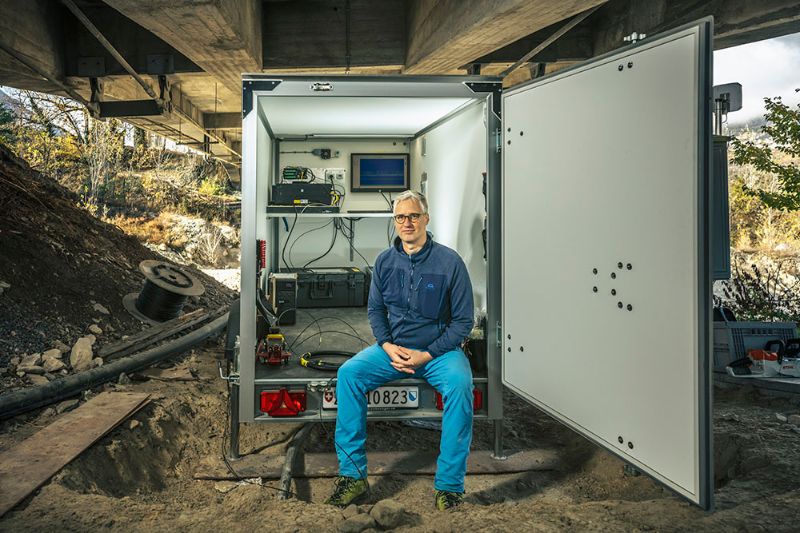A geological anomaly as a stroke of luck for research
It is like a wound in the countryside. The Illgraben. It runs south from the Rhône Valley, not far from Sierre. One moment you have nature alternating with urban sprawl, the next a lunar landscape. Geology leaves no room for the vegetation to spread here. The slopes slide far too often, and the rocks are far too loose. This area is dominated by rock and scree. Trees only grow on the southern flank of the gorge. As a result, the bare rock is mostly exposed and constantly impacted by the weather, which does its job very diligently. Downstream, the Illbach transports the material into the Rhône, which regularly causes the river to become cloudy when it rains. Hiking trails? Not a chance. “The Illgraben is one of the most inhospitable places I know,” says WSL seismologist Fabian Walter.
Hostile and irreplaceable
It may be hostile, but it is conducive to research. The geological anomalies are a stroke of luck for WSL. One could also say that if the Illgraben did not exist, it would have to be recreated as a test site. After all, natural hazards that otherwise only occur sporadically and are unpredictable can be studied here almost by appointment. “There are up to a dozen debris flows per year, or rather, per summer in the Illgraben,” says Walter. For this reason, WSL has been operating the “Illgraben debrisflow observation station” since 2000 in order to gain a better understanding of debris flows with various research projects. Measuring devices in the area of the streambed record the passage times, pressure and discharge height of each debris flow. Walter, however, has placed his devices all over the terrain, even in places far from the valley floor. As a seismologist, he is particularly interested in the tremors caused by debris flows.
The special thing about debris flows is that they carry a lot of sediment, mud and stones. “Water alone can also be dangerous, but only debris flows can carry away rocks the size of a car.” This is one of the reasons why debris flows are “seismologically very loud”, as the expert puts it. They can therefore be detected very well with the usual sensors used by seismologists, which allows for completely new approaches for alarm systems. The seismographs also measure in areas that are difficult to access and register debris flows extremely quickly.
Real-time analysis for a faster warning system
But debris flows can also be detected using simpler methods. It could be a wire that breaks or a pendulum that hangs over the streambed and triggers an alarm as soon as it is moved. However, installing this type of sensor would be a challenge, as is evident from the lunar landscape in the Illgraben. Where everything is slippery, fixed installations close to the mud flow are a contradiction in terms. By contrast, seismographs distributed throughout the Illgraben can detect the debris flow much further up. This buys valuable time in the event of an alarm. It can take a good 20 minutes to several hours for such a debris flow to reach inhabited areas. Intelligent algorithms analyse the seismic data in real time and issue an immediate warning if something is brewing high up in the gorge or if the rumbling begins.
However, these algorithms must first learn to isolate and correctly interpret the signals from the debris flows. This is where artificial intelligence comes in. Walter’s team is in the process of training corresponding models with data from measured debris flows. For this purpose, 100 sample data sets are sufficient, which the experts can extract from 10 to 20 events. The software thus learns to identify debris flows as an anomaly in everyday seismic noise. This means that the alarm can no longer be triggered by trampling cattle, traffic and industrial noise in the ground.
The magic lies in the algorithm
They are currently working on simplifying the seismographs in order to make the system suitable for everyday use and also commercially interesting. “We don’t need professional measuring devices for this application, which can cost around CHF 15,000 to CHF 20,000,” says Walter. The magic lies mainly in the algorithm. What it has learned in the Illgraben will hopefully soon be very useful in other Alpine valleys too. In this respect, the at times wet summer of 2024 provided important measurements for research and for future debris flow predictions, says Walter.
Optical fibres
Stateoftheart data processing also means that signals can suddenly be found in unexpected places. Thanks to close collaboration with ETH Zurich and Swisscom Broadcast Ltd, WSL is currently investigating whether optical fibres can be used as vibration sensors for monitoring natural hazards. “It may well be that we never have to install a seismometer again,” says Fabian Walter. This is because if an earthquake pulls on the fibreoptic cable, it shows up as the smallest disturbance in the signal. These disturbances can be spatially resolved, meaning that virtual measuring devices are available every metre or decimetre along a fibreoptic cable without any additional infrastructure costs. In this respect, there are already “millions of seismometers” across the country, even over mountain passes. Initial test runs at the Flüela Pass have shown that the system can reliably detect avalanches. The method is to be continuously refined over the next few years.
